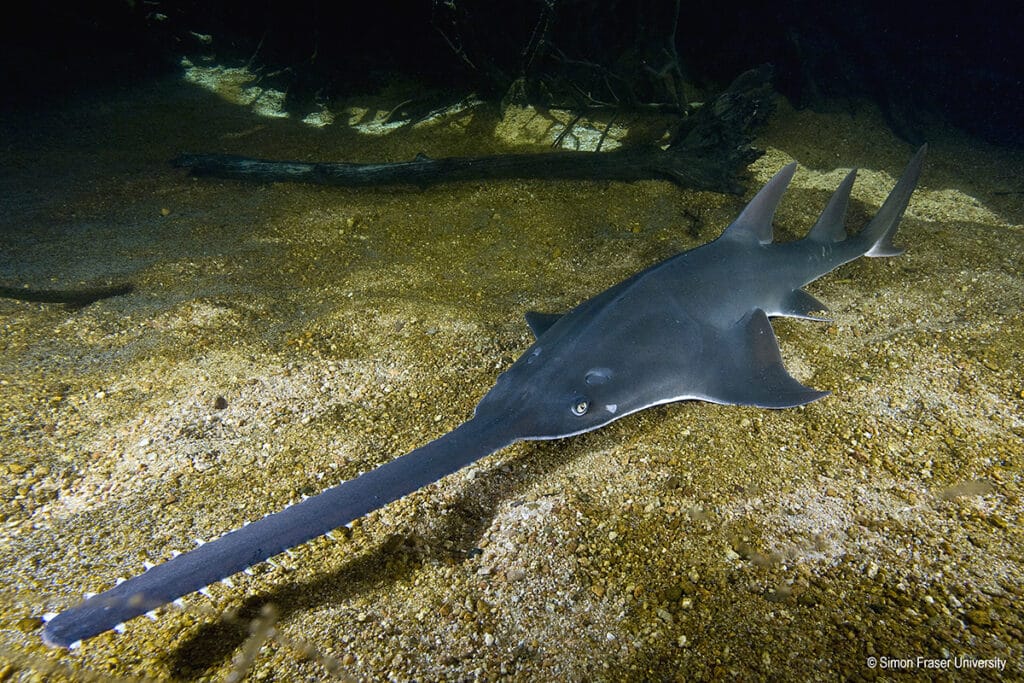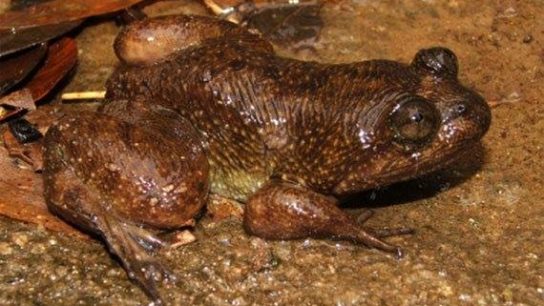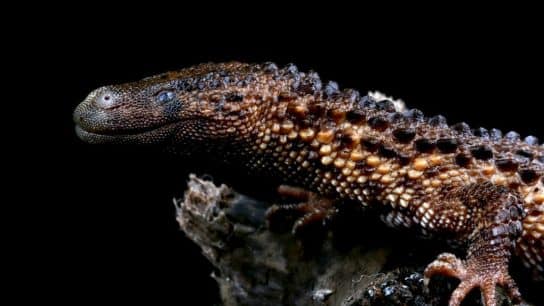The largetooth sawfish is one of five species of sawfish under the Pristidae family, characterised by long, flattened rostrums lined with staggered teeth. Although commonly referred to as carpenter sharks, and not to be confused with sawsharks (Pristiophoridae), sawfish are actually a family of rays. The largetooth sawfish is a euryhaline fish, able to adapt to a wide range of salinities, and can therefore be found in both freshwater and saltwater environments such as estuaries, rivers, lakes and marine waters. Despite a historically widespread circumtropical distribution, the species is reported to be ‘possibly extinct’ in 19 of its 60 former range states and its presence in a further 14 states is undetermined. Once considered to be amongst the most valuable species in the shark fin trade, decades of exploitation, unsustainable fishing practices, and habitat degradation have caused significant declines in the global largetooth sawfish population.
—
Family: Pristidae
Genus: Pristis
Species: Pristis pristis (synonyms: Pristis microdon and Pristis perotteti)
IUCN Status: Critically Endangered
Population: Unknown
1. Diet
The diet of a juvenile largetooth sawfish primarily consists of benthic invertebrates, mollusks, and crustaceans (crabs and shrimps), and gradually includes a variety of small schooling fish (herring and mullet) as the sawfish matures. The animal’s rostrum, which accounts for almost one quarter of their body length, plays a critical role in hunting. Apart from stirring sediment on the ocean floor in search of prey, a sawfish will rapidly swing its rostrum from side to side in order to stun, impale and slice schooling fish before consuming them. An evolutionary marvel, the rostrum of a sawfish barely disturbs surrounding water as the animal swims, making these stealthy hunters undetectable to potential prey. Sawfish have also been observed burrowed in sand, lying in wait for prey, as well as using their rostrum to pin down prey to the ocean floor.
As with all sharks, rays and skates, the sawfish has specialised electro-sensory organs, called ampullae of Lorenzini, which it uses to hunt for prey. These electroreceptors, which form a network of mucus-filled pores across the ventral and dorsal surface of a sawfish’s rostrum, can detect electrical fields emitted by nearby prey. In fact, the largetooth sawfish has more ampullary pores than any other species, due to the fact that they often inhabit low-visibility freshwater habitats, and is therefore considered to be an electroreception specialist. Since they do not rely on sight, sawfish are strictly nocturnal and only hunt at night.
Although larger specimens of largetooth sawfish are not typically preyed upon, smaller individuals are reportedly attacked by sharks and crocodiles on occasion. Juvenile largetooth sawfish utilising freshwater rivers as nurseries are more vulnerable to predation, often attacked by terrestrial predators, such as eagles, or freshwater crocodiles.

In a study by Murdoch University, Associate Professor David Morgan presented a photograph of a crocodile attacking a largetooth sawfish in Western Australia’s Fitzroy River. Photo: Western Australia Department of Parks and Wildlife/EPA.
2. Appearance
The largetooth sawfish is the largest of the five species, reaching a maximum length of 705 centimetres. Both males and females mature at a length of 300 centimetres, at the age of eight to ten years. Newborns are around 76 to 90 centimetres long and grow by 38 centimetres in their first year of life. At the embryonic stage, the rostrum of sawfish are flexible and soft, with a sheath of tissue enclosing rostral teeth to protect the mother during birth.
Although the largetooth sawfish greatly resembles a shark, it is actually a species of ray. The head of a sawfish is ventrally flattened, its pectoral fins are connected to its head, its gills, mouth and nostrils are located on its underside, and it has spiracles on the top of its head which are used to circulate water through the gills for respiration when inactive – all of which are morphological features of rays. Largetooth sawfish that reside in saltwater habitats tend to be dark grey to golden brown in colour, with a cream-coloured belly. Those found in freshwater environments are lighter grey with red colouration around the back, lower sides, as well as the second dorsal and pelvic fins. Although distinguishable from other species of sawfish by their proportionally larger pectoral fins, the distinct lower lobe on their caudal (tail) fin, and the forward positioning of their first dorsal fin, the main distinguishing feature of the largetooth sawfish is its rostrum.

Largetooth Sawfish Pristis pristis released after being rescued from a drying floodplain waterhole in northern Australia. Photo: Peter Kyne.
The rostrum of the largetooth sawfish is more robust than that of other species, and has a fewer amount of “teeth” that are slightly larger in size. Although commonly referred to as teeth, the razor-sharp denticles on the rostrum of a sawfish are actually modified placoid (teeth-like) scales, similar to the ones found on their skin. It has 14 to 23 rostral teeth uniformly spaced on each side of the snout, whereas the smalltooth sawfish has approximately 20 to 30. These teeth grow throughout life and their weight is minimal, making the sawfish well adapted to hunting fast, agile prey. Deeply rooted in hard cartilage, the rostral teeth of sawfish do not grow back if damaged at the root, unlike the teeth of other ray and shark species, and are kept short by regular abrasion on the substrate. Sawfish also have buccal teeth, which are typically used to crush their prey before digestion. They have 12 rows of 80 to 90 teeth in each jaw, which are dome-shaped at the front but have a blunt cutting edge at the back.
Fossil records and morphological comparisons between elasmobranchs with elongated rostrums have indicated that both families of sawfish, pristids (extant species of sawfish) and sclerorhynchids (extinct species of sawfish), evolved independently from shovelnose rays (Rhinobatidae). Sawsharks, on the other hand, are believed to have evolved from squalomorph sharks, making the similarities in the specialised saw-like rostrums of all three families an incredible example of convergent evolution.
The elongated rostrum is thought to have evolved primarily for feeding, as a result of external ecological pressures. Random mutations that resulted in initial changes to the rostrum, making it slightly longer with strengthened lateral edges and bigger dermal denticles, could have allowed ancestors of sawfish to manipulate larger, faster, more agile prey with rapid slashing motions, therefore expanding their prey selection. Alternatively, since the largetooth sawfish has been observed using its rostrum to pin prey down onto the substrate, and does so more easily than the shovelnose ray as it uses its pectoral fins to reposition itself over the prey, some speculate that the elongated rostrum evolved initially for prey immobilisation with the lateral teeth forming as a secondary adaptation for slicing.
Another theory for the evolution of the elongated rostrum is sensory optimisation. As has been suggested for the evolution of cephalofoils in hammerhead sharks, an elongated rostrum allows for an expansion of sensory receptors, such as ampullae of Lorenzini and neuromasts (a mechanoreceptive organ which senses mechanical changes in water), and therefore increases the animal’s electric and hydrodynamic ranges. Supporting this notion is the density of ampullae of Lorenzini found on the rostrums of extant rhinobatid shovelnose rays, which can be seen as an evolutionary stage preceding the elongation of the rostrum. Finally, some speculate that sclerorhynchids (extinct sawfish species) developed elongated rostrums for self-defence, as they were small benthic rays with a weak tail and unspecialised teeth. Extant sawfish species have also been observed using their rostrum for self-defence.
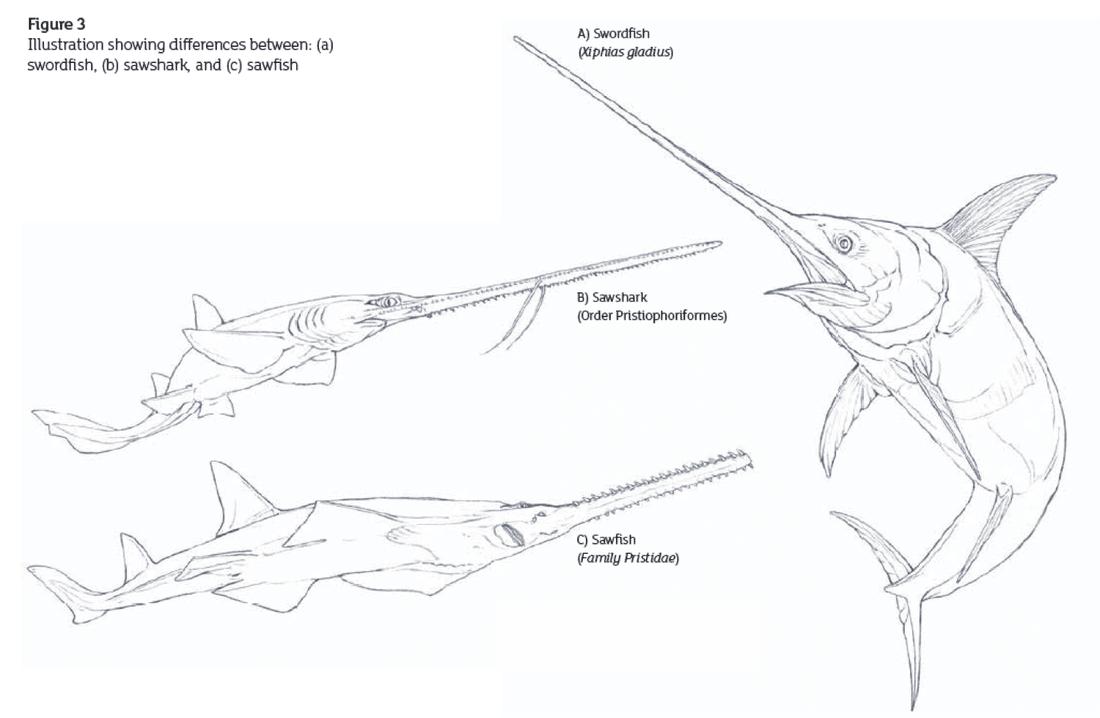
IUCN SSG illustration differentiating the swordfish, sawshark, and sawfish.
Like sharks, the skin of a sawfish is made of dense, placoid scales known as dermal denticles, which point towards the tail of the sawfish. The scales of a largetooth sawfish are ovoid in shape and more widely spaced over its dorsal surface. As the sawfish grows, the scales do not get larger but rather the sawfish grows more scales. Apart from protecting the animal against attacks from predators, these dermal denticles help sawfish swim faster, as the hydrodynamic shape of the scales allows water to pass more freely over the surface of the sawfish and reduces friction.
You might also like: 10 of the World’s Most Endangered Animals
3. Habitat & Behaviour
Of all five species of sawfish, the largetooth sawfish has the largest historical range and is comprised of four subpopulations: Western Atlantic (Gulf of Mexico to Brazil), Eastern Pacific (southern Mexico to Peru), Eastern Atlantic (Namibia to Mauritania), and Indo-West Pacific (Australia and southeast Asia to eastern Africa). Nevertheless, the species is reported to be ‘possibly extinct’ in 19 of its 60 former range states and its presence in a further 14 states is undetermined. In the United States, there have been no reported largetooth sawfish sightings since 1961. Due to the scarcity and inadequacy of records, lack of surveying and reporting, the recurring issue of species identification, and a significant knowledge gap on the ecology, biology, and baseline distribution ranges of the species, its global abundance remains uncertain. Observations suggest that the largetooth sawfish is still present in several countries on the Amazonian Coast (northern coast of South America), as well as in Northern Australia, and these populations are considered to be the most significant strongholds at present.
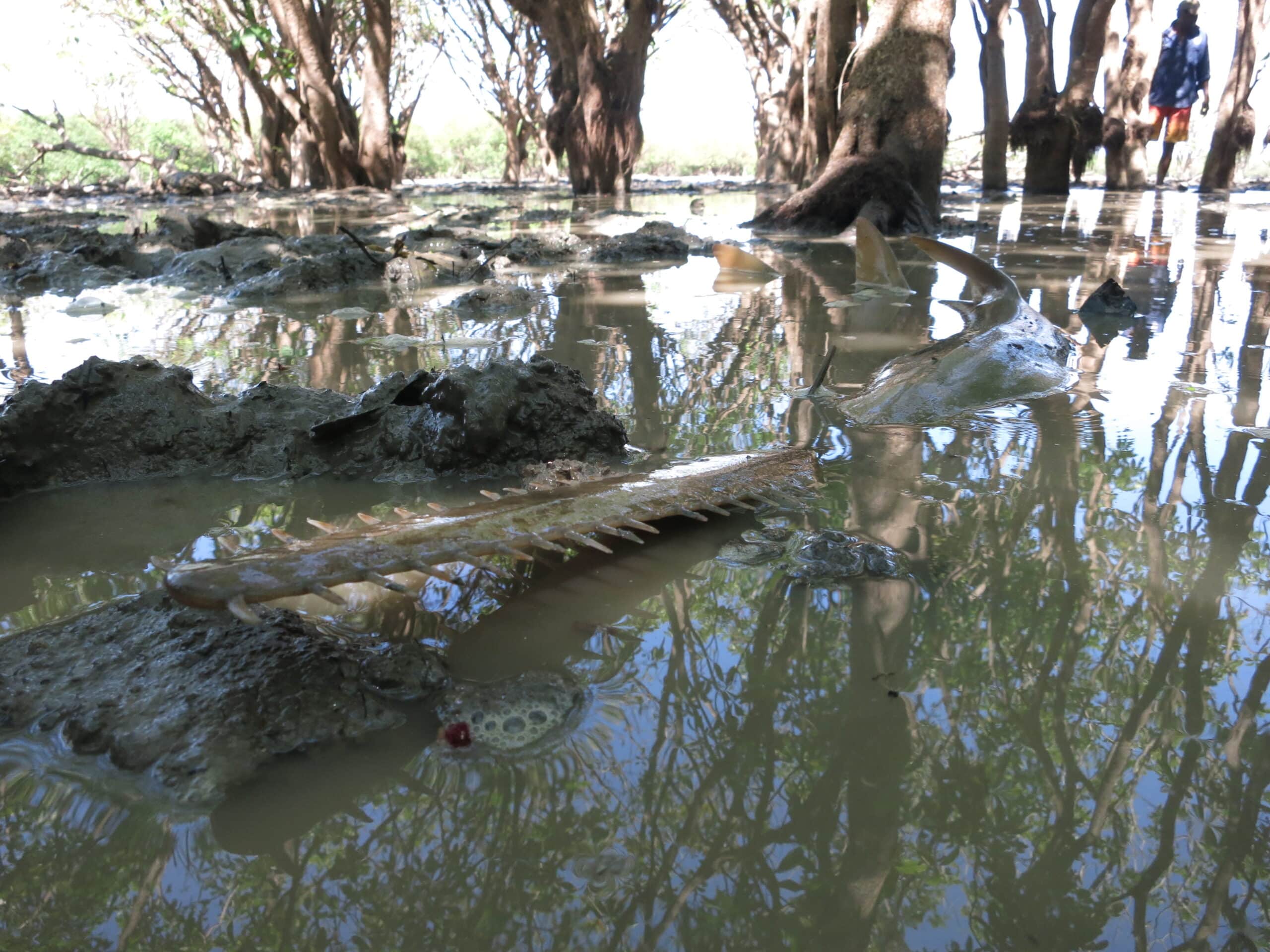
The largetooth sawfish inhabits a variety of freshwater and saltwater environments. Photo: Brit Finucci.
The largetooth sawfish is a euryhaline species, meaning that it can inhabit marine environments of varying salinities. To avoid predation, juveniles are typically found in shallow freshwater environments, such as freshwater rivers, lakes, and estuarine habitats, for their first four to five years of life. When venturing into extremely shallow waters, with a depth of 20 centimetres or less, juvenile sawfish have been observed collapsing their dorsal fins to avoid detection from terrestrial predators, such as eagles. As the largetooth sawfish grows, it tends to utilise more marine and brackish coastal habitats, including wetlands, bays, estuaries, lagoons, seagrasses, and mangroves. Nevertheless, adult sawfish have been observed far up inland river systems, including reports of the species in the Amazon River up to 750 km inshore, and as far as 100 kilometres offshore. Some may spend their whole lives in freshwater, such as those found at Lake Nicaragua, only entering saltwater to reach other rivers. With a preference for warm tropical and subtropical waters, the largetooth sawfish rarely descends to depths greater than 10 metres, although specimens have been found at depths of 122 metres in Lake Nicaragua.
The largetooth sawfish is ovoviviparous, meaning that embryos are developed internally whilst being nourished by a yolk sac and females then give birth to live young. After a gestation period of approximately five months, litters usually consist of one to thirteen pups, although seven to nine is the average reported litter size. Upon reaching sexual maturity at the age of eight to ten years, females reproduce annually or biennially. As a result, largetooth sawfish populations grow at an extremely slow rate.
In 2015, scientists studying a small wild population of smalltooth sawfish in Florida were surprised to discover that some females had reproduced asexually. Although asexual reproduction, or parthenogenesis, has been observed in various species of sharks, snakes and fish kept in captivity, such so-called “virgin births” were believed to be extremely rare and had never been observed in wild vertebrates. DNA fingerprinting revealed that 3% of the sawfish population studied had been created through female-only reproduction, indicating that this method of reproduction may play a critical role in the survival of some critically endangered species. Although asexual reproduction may deplete genetic diversity within a population, scientists believe that it may be used as a “bridging strategy” during critical periods to overcome population bottlenecks. The long-term impacts of these findings, and whether other species of sawfish employ the same reproductive strategy, are still undetermined.
4. Ecosystem Services
For a conspicuous species with a widespread circumtropical distribution, the biology and ecology of the largetooth sawfish are poorly understood and existing data is fragmentary. Most studies of the species have been conducted on populations located in Lake Nicaragua and northern Australia, which may not be representative of other subpopulations. Nevertheless, as a top predator, the largetooth sawfish undeniably acts as a critical member of the tropical and subtropical estuarine ecosystems it inhabits. Apart from controlling populations of prey species, culling sick or injured individuals, and maintaining balance within the food chain, the largetooth sawfish may play other crucial roles in their freshwater and marine communities that have yet to be determined. If driven to extinction, the loss of the largetooth sawfish would undoubtedly have destabilising effects on coastal and freshwater ecosystems.
5. Threats
Recognised as being “among the most threatened elasmobranchs” in the world by the International Union for the Conservation of Nature and Natural Resources (IUCN), all four species of sawfish under the genus Pristis have been classified as ‘Critically Endangered’ since 2006. Due to its toothed rostrum, which renders the species especially susceptible to entanglement in fishing gear, the high value of its appendages and organs, its vulnerability to both marine and freshwater habitat degradation, as well as its slow reproductive rate, the largetooth sawfish is estimated to have suffered a population loss of at least 80% over the past 68 years (three generations).
The commercial exploitation of sawfish, driven by the financial and cultural significance placed on their rostra, rostral teeth, fins, meat, organs, and liver oil, has been documented since 1938. Rostra is sold globally as trophies, status symbols, decorations, ceremonial weapons, and curios, playing an important role in the cultural mythologies and rituals of tribal societies in Central America, West Africa, Papua New Guinea, and Australia. In the Persian Gulf, sawfish were once so abundant that fishermen utilised their rostra to build fences around their properties. Traditional medicinal practices in China, Mexico, and Brazil have also historically used rostra in remedies for illnesses such as asthma. Before eBay banning the auction of sawfish parts on its platform in 2006, the site served as one of the primary marketplaces for the appendages, with each rostra fetching up to 1,500 USD. Rostral teeth are also sold globally as curios, crafted into tools in Southeast Asia, and used as cockfighting spurs in Ecuador, Panama, and Costa Rica. Although sawfish meat is typically consumed by local coastal communities and rarely enters the international market, the fins of sawfish are amongst the most valuable in the global shark fin trade and can fetch up to 4000 USD for a set. In 2007, all five species of sawfish were listed under Appendix I of the Convention on International Trade in Endangered Species of Wild Fauna and Flora (CITES), effectively banning the international sale of sawfish parts. Nevertheless, due to the high financial value they hold, the illegal sale of sawfish rostra and fins reportedly continues. As recently as 2020, sawfish fins were seized in Hong Kong.
As a consequence of their unique rostral morphology, sawfish are easily caught as bycatch in commercial gill-net and trawl fisheries. Inhabiting shallow coastal and freshwater habitats that are often subject to unregulated or poorly managed fishing pressures, both commercial and small-scale (artisanal, cultural, recreational, and subsistence fishing), sawfish caught as incidental bycatch are often retained due to the difficulties associated with untangling them from gear as well as the high financial value they hold (approximately 14,000 USD per individual sawfish). In September 2019, a two-week expedition to tag sawfish in Northern Australia believed to be one of two remaining global strongholds for sawfish, ended with no sawfish sightings. In the Flinders River, Queensland, fishermen targeting freshwater prawns with cast nets have reported capturing largetooth sawfish, as freshwater prawns are a primary prey source for the species in the region. Conservation groups in Queensland have highlighted the need for renewed restrictions on the Gulf of Carpentaria Inshore Fin Fish Fishery. Along the KwaZulu-Natal coast of South Africa, sawfish were frequently caught as bycatch in shark fisheries in the 1980s and 1990s, yet the species are now considered to be locally extinct in the region. Sawfish were also once commonly caught in coastal shark fisheries in northwest Madagascar, but intense netting across estuaries resulted in extensive population declines. Given the lack of training provided to fishermen on the safe disentanglement of sawfish from gear, as well as the absence of independent observers on fishing vessels to verify bycatch numbers and avoid underreporting, the extent of the fishing industry’s impact on sawfish populations, although quantifiably undeterminable, is likely understated.
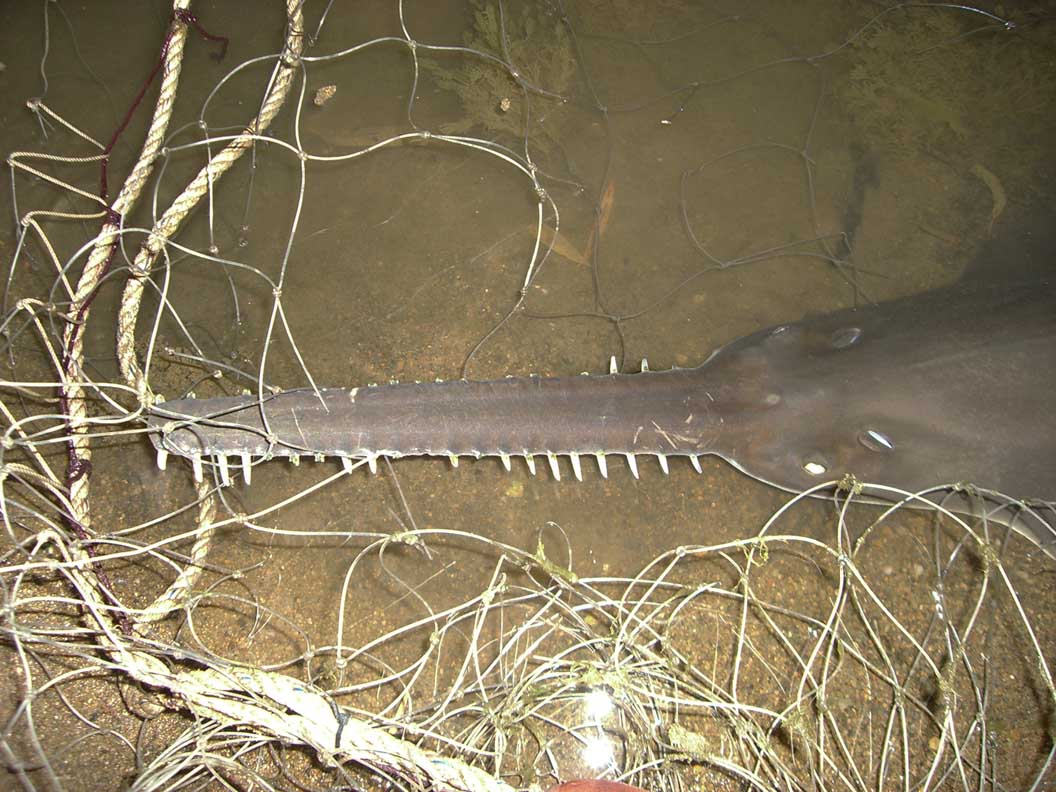
Sawfishes are caught by a wide range of fishing gears due to their tooth-studded rostra being easily entangled. Photo: Jeff Whitty.
The largetooth sawfish is also highly vulnerable to habitat loss and degradation given that the ecosystems the species inhabits, namely inshore coastal and freshwater environments, are commonly affected by human activity. Damming, underwater mining, dredging, agriculture, and coastal development projects have greatly reduced both the quantity and quality of riverine and coastal habitats within the species’ range, with consequential nutrient run-off and pollution having devastating effects on the vitality of ecosystems. Globally mangrove cover has declined by 20 to 35% since 1980, and seagrass cover has been reduced by 29% since the late 1800s. As juvenile sawfish are heavily reliant on freshwater areas as nursery habitats, changes in river flows and natural flooding events caused by damming projects negatively impact population recruitment. The estuary system of St. Lucia, once considered to be an important habitat and breeding area for sawfish, suffered reduced water flows as a result of agricultural and industrial expansion. Consequently, sawfish have disappeared from the region.
The plight of the largetooth sawfish has only garnered global attention in recent years. Emerging knowledge of the impacts of anthropogenic pressures on marine environments has shed light on the relative risk of extinction faced by all Chondrichthyes, however, scientists have encountered numerous challenges in creating conservation strategies for these species. With such vast geographic ranges and inadequate historical records, the taxonomic classification of sawfish species was not consolidated until 2013, when a global compilation of morphological and genetic data confirmed the existence of just five species in the family Pristidae. As a result of this taxonomic discrepancy, the credibility of historical data collected on the life history, biology, ecology, status, and distribution of global populations is uncertain. Given that scientists and conservationists now find it extremely difficult to locate individual largetooth sawfishes to tag and monitor, and with their protected status limiting any intrusive biological studies, there is little prospect of gathering further information on the species. This will inevitably have an impact on the effectiveness of conservation measures, at least until advances in technology enable scientists to better understand the biological needs of the species without invasive monitoring methods.
6. Conservation
Given the life history parameters that limit the largetooth sawfish to a slow intrinsic rate of population increase – low fecundity, late age sexual maturity, long gestation periods, and the potential for intermittent breeding – effective conservation actions are critical for the future survival of the species. The largetooth sawfish has been awarded protections in both international and national legislation, and in 2014 the IUCN SSC Shark Specialist Group established a Global Sawfish Conservation Strategy with recommendations for the development of global and regional conservation programmes. Scientists, conservationists, and NGOs working at a regional level have further implemented initiatives to minimise bycatch, monitor local populations of sawfish, and gather scientific data on each species. Nevertheless, the continued decline of the global largetooth sawfish population, as well as the inaction of some key range states, indicates that increased public, political, and financial support is crucial to prevent the extinction of the species.
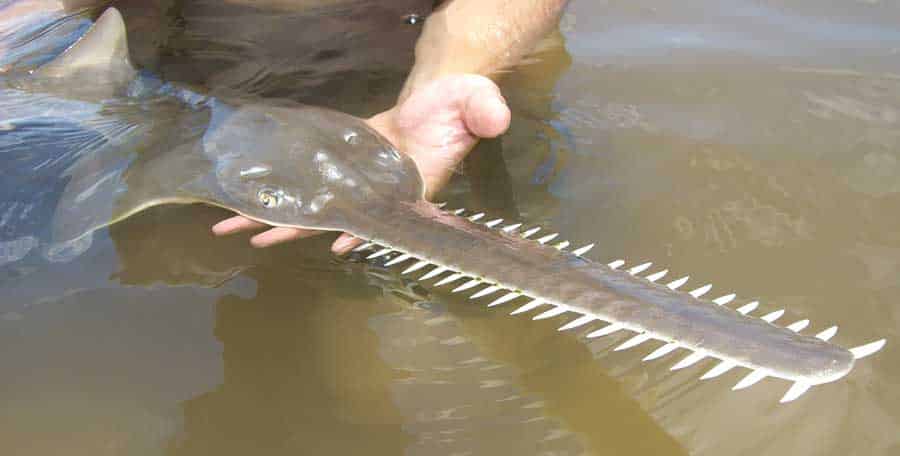
Tracking Critically Endangered Indo-Pacific subpopulation of Largetooth Sawfish Pristis pristis in the Kimberly region of northern Australia. Photo: David Morgan.
The largetooth sawfish is listed under Appendix I of the Convention on International Trade of Endangered Species (CITES), banning any commercial international trade of the species, as well as Appendix I and II of the Convention on Migratory Species (CMS), which obligates Parties to act nationally and cooperate regionally to protect sawfish. In 2012, the General Fisheries Commission for the Mediterranean (GFCM) further banned the retention of the largetooth sawfish and mandated careful release, although parties to the GFCM have been slow to implement the restrictions nationally. In the Wider Caribbean Region, the largetooth sawfish is listed in Annex II of the Protocol for Specially Protected Areas and Wildlife of the Cartagena Convention, which obligates parties to grant the species strict protections. Despite these binding international treaty mandates, the largetooth sawfish remains largely unprotected in several countries. Analyses conducted in 2018 indicated the need for concerted, international conservation policy action in four priority regions: the Caribbean, Amazon Delta, Western Indian Ocean, and Australasia.
Nationally, species-specific protection of the largetooth sawfish exists in 17 countries: Australia, Bangladesh, Brazil, Colombia, Costa Rica, Ecuador, Guinea, India, Indonesia, Malaysia, Mexico, Nicaragua, Pakistan, Panamá, Perú, Senegal, and South Africa. However, reports indicate that enforcement of legislation is generally poor in states with limited governmental resources and high poverty rates. A study conducted in 2021 highlighted the critical need for domestic sawfish protections in nations where the presence of the largetooth sawfish is uncertain, low, or declining, but where extinction probability is still low: Mexico, Panamá, Brazil, Madagascar, and Sri Lanka. Papua New Guinea, where largetooth sawfish are still observed regularly but which has failed to apply species-specific bans on killing, retention, sale, and trade, is also deemed a priority for conservation initiatives.
In 2012, the International Union for Conservation of Nature Species Survival Commission’s (IUCN SSC) Shark Specialist Group (IUCN SSG) convened the Global Sawfish Conservation Strategy Workshop with four key objectives: to summarise the state of knowledge of sawfishes and conservation capacity worldwide; to map the geographic range status for each species; to reassess the status of sawfishes by applying the IUCN Red List categories and criteria; and to develop a Global Sawfish Conservation Strategy. The workshop was arranged to ensure extensive representation with regard to geographic region and expertise, with a particular focus on involving those with the highest interest in the preservation of sawfishes: conservationists, scientists, government officials, resource managers, etc. After several discussions and plenary sessions, the workshop resulted in the development of several goals, objectives, and actions to reach a common vision, “a world where sawfishes are restored – through understanding, respect, and conservation – to robust populations within thriving aquatic ecosystems”. After the workshop, guidelines for the development of regional and national conservation strategies were provided. The multinational collaborative effort that ultimately resolved the taxonomic discrepancy within the sawfish family in 2013 greatly supports the notion that a global conservation planning initiative would bolster national and international protection efforts and render them more efficient.
Arguably more effective approaches to minimising bycatch and illicit fishing practices are those employed by conservationists and NGOs working at a regional level with fishermen and local populations. In Australia, education initiatives, training fishermen in the safe release of sawfish and identifying bycatch at a species-specific level, and other community capacity-building efforts have been crucial for the protection of largetooth sawfishes inhabiting marine and freshwater environments near human settlements. Some bodies of water in Northern Australia, where sawfishes have been observed, have also been closed to gill-net fishing, and the prawn trawling industry has made considerable improvements in ensuring the survival of marine life caught as bycatch. In Bangladesh, National Geographic EDGE fellow Alifa Haque has been working to improve the reporting system for sawfish bycatch in coastal fishing villages. EDGE has further established five objectives of critical importance in a national conservation blueprint for the largetooth sawfish in Bangladesh: to reduce bycatch mortality through community-led release programmes; to disincentivise traders and fishers from retaining bycatch; to reduce trade through innovating monitoring mechanisms; to protect critical habitats; and to increase knowledge on the species and educate local communities. In Costa Rica, Professor Mario Espinoza, a marine scientist at the University of Costa Rica, was instrumental in lobbying the Costa Rican government to award sawfishes legal protections, which were enacted in 2017. Professor Espinoza had his team continue to raise awareness nationally through his sawfish conservation initiative, En Busca del Pez Sierra – Costa Rica. The project aims to promote education in local fishing communities regarding the legal protection of sawfishes by introducing methods of minimising bycatch and systems for reporting sightings.

Due to the rarity of largetooth sawfishes, innovative monitoring techniques, such as environmental DNA, are increasingly being used. Photo: Peter Kyne.
Countries where the legislative enforcement of fishing prohibitions is lacking, particularly those with limited governmental resources and high rates of poverty, require a more holistic approach to conservation. Ruth Leeney, a National Geographic Explorer and scientist at the Natural History Museum of London, has worked in sawfish conservation across ten countries in Africa and Asia, noting that long-term, effective conservation initiatives in such regions cannot follow the same top-down approach used in the US and Australia. Working with local communities and taking into account the specific culture and socioeconomic context of each country will enable conservationists to establish programmes that decrease the current exploitation of natural resources by introducing alternative sources of livelihood for locals. By demonstrating the intrinsic value of environmental protection and sustainability, particularly the restoration and conservation of coastal ecosystems such as mangroves and seagrass beds, conservationists can work towards protecting sawfishes and their natural habitats with community-led projects that tackle issues of food scarcity.
Lastly, as scientists and conservationists became increasingly aware of the plight of sawfishes and the concerning lack of biological and ecological data on each species, a surge of research activity was initiated primarily in Florida, the USA, South America, and Australia. Scientific data is crucial for the development of status assessments, management measures, and recovery plans, which, combined with local education and outreach programmes, resulting in effective protections being awarded to remaining sawfish populations worldwide. In 2019, Professor Colin Simpfendorfer, a marine scientist at James Cook University, initiated a Global Sawfish Search project utilising environmental DNA. Supported by the Save Our Seas Foundation, the project involved experts from around the world sampling marine and wetland environments for trace amounts of sawfish DNA (also known as environmental DNA); a method that can detect evidence of sawfishes over nearly a kilometre stretch of water over a three to four-day window. The project aimed to determine where conservationists should focus their efforts for the recovery of viable populations, which was outlined as a critical objective by the Global Sawfish Conservation Strategy.
NGO Spotlight: Sawfish Conservation Society
The Sawfish Conservation Society is a nonprofit group based in Florida, USA, which takes a multifaceted, collaborative approach to the protection of sawfish and aims to connect the world to advance global sawfish education, research, and conservation. By working together with aquarists, museums, researchers, educators, and NGOs, the SCS and its partners have supported one another in maximising their influence and scope, making significant progress in the protection of sawfish.
In 2017, the SCS assisted in establishing the first International Sawfish Day (October 17th) to celebrate and spread awareness of the value of sawfishes, and the organisation continues to collaborate with partner aquariums yearly to promote ISD across the world via social media, press releases, and other awareness-raising events. The SCS further provides a range of insightful materials and resources for educators and members of the public to promote and host an International Sawfish Day event, establish education and outreach programmes in schools, towns, and cities across the world, and encourage the protection of sawfishes and their natural habitats. These materials were designed in collaboration with international researchers, gathering their input on what materials and messages they believed would maximise education and outreach efforts. The SCS has also worked with partner aquarists to raise funds for a yearly research grant that is distributed to one research project during ISD.

The SCS further provides extensive, detailed biological and ecological information on each species of sawfish and the threats they face, which will hopefully encourage future generations of conservationists and ecologists to take an interest in sawfish protection. In-depth species identification resources are also available on the SCS website to aid fishermen with species identification when sawfish are caught as bycatch. Improvements in species-specific bycatch data would aid conservation efforts tremendously, helping establish areas to enact stricter fishing prohibitions and potential sights for research and data collection. The site further outlines procedures for the safe disentanglement and reporting of sawfish for the general public.
In addition to educating the public, the SCS assists researchers with their work wherever and wherever possible. This includes providing letters of support to get conservation projects up and running, providing tools and resources to assist with research initiatives, providing online platforms for researchers to promote their work and fundraising initiatives, and sparking discussions on recent events. The SCS further utilises International Sawfish Day to promote the work of researchers on a greater scale.
How You Can Help
- Host an International Sawfish Day event. Educate the community around you on the importance of sawfish conservation and the ways that they can help make a difference. You can find all the materials you need on the Sawfish Conservation Society’s website.
- Participate in environmental clean-ups. All waterways lead to the ocean, so whether you’re participating in a beach, river, or general environmental clean up, that’s less rubbish entering the ocean and polluting the ecosystems that sawfish inhabit.
- Support sawfish research. There are several NGOs and scientists that are trying to shed light on the biological background of sawfish to help create more effective protection strategies. You can donate to an organisation such as the Sawfish Conservation Society, which helps provide grants and support to researchers across the globe.


Featured image: David Wackenfelt for Simon Fraser University
If you enjoyed this article about the endangered Eastern gorilla, you might also like: Red Pandas: Endangered Animals Spotlight










